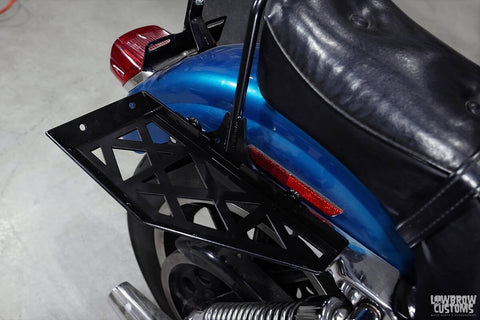TABLE OF CONTENTS
- Find a customizable bike to turn into a bobber
- What is the best Harley-Davidson motorcycle base for a bobber?
- Best Triumph for a Bobber build
- Top under $1000 motorcycles for a cheap bobber project
- How to build a bobber motorcycle?
- Choose the Parts for Your Custom Bobber Project Wisely
- Get a Comfort and Handling Bobber Frame
- Modification to change the Front end of Bobber build
- Bobber wheels and rims that fit your axles, front end and frame properly
- Looking for Custom Gas Tanks That Look Great on a Bobber
- Choose Useful Fenders for Bobber Style
- Consider Oil tank for bobbers
- Modify the Bobber Seats
Here at Lowbrow Customs we are known world-wide for a large array of bobber parts and chopper parts. Based on our interactions with customers over the last 16+ years, we figured this article could be useful for those who want to turn their thoughts on building a customer bobber motorcycle into reality.
This article is a good overall base of information that should help you make informed decisions, such as which motorcycle is right for your project, keeping within a budget, and various parts options. We hope you enjoy it!
What makes a bobber motorcycle?
The designation ‘bobber’ can be wide-ranging and is open to many interpretations. For a broader perspective on its roots and cultural significance, the history of the chopper and bobber delves into how these styles emerged and evolved.

In the 1940’s and 50’s motorcycle racing was gaining in popularity, and flat track racing was commonplace across large swaths of the United States as a dirt oval was a low barrier to entry when it comes to building a motorsports race track.
The start and the Rise of Bobber Motorcycles
Fast forwarding half a century, the term bobber became part of the motorcycle vernacular. The origination and history of the bobber tends to be loosely understood, and bikes that span across most of the microcosms of custom motorcycles have likely been referred to as a bobber from time to time.
There are a series of identifying characteristics that help classify a motorcycle as a bobber. Of course, there are the vintage motorcycles that started the entire style, but these days the bobber aesthetic can be and has been applied to any sort of motorcycle you can imagine.
Not content to watch or partake in racing and then putt around on a stock motorcycle, many motorcyclists took to giving their street motorcycles a bob-job to lighten it up and increase the speed and handling. These modifications also differentiated these early bobbers from other stock bikes.
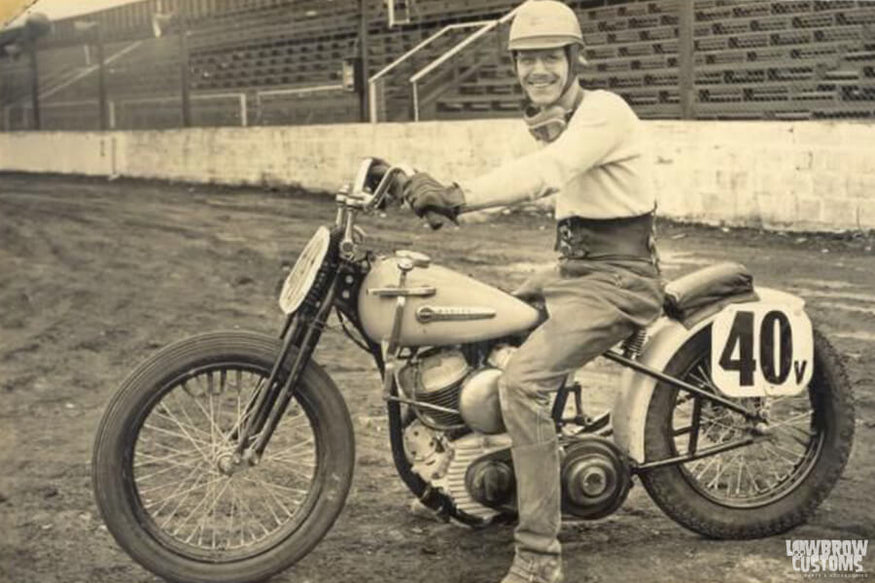
This style of customization by subtraction was not limited to any certain model but found across all types of bikes, including Harley-Davidson Big Twin Knuckleheads and Panheads as well as Indians and other makes.
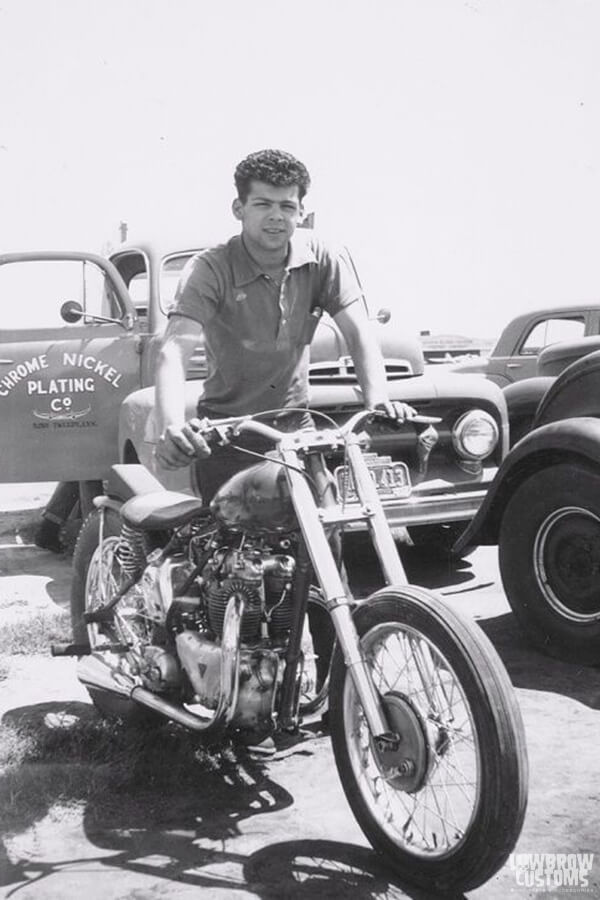
Bobber motorcycles became popular when people were getting more creative with their bob-jobs.
Find a customizable bike to turn into a bobber
Pros and cons to consider when choosing a motorcycle for the basis for a bobber include parts availability, level of complexity, and cost.
Parts, both used, original as well as reproduction OEM parts, are available for many popular bikes, though if a less common motorcycle is used you may find trouble in finding high-quality parts at a reasonable price.
However, if your motorcycle is quite complete and in good mechanical order this may not be too much of a concern. In addition to this, the complexity of the motorcycle in question can make the customization process more difficult, though not unsurmountable.
Typically, the overall look of the bike would have vintage styling, with simplicity being key. Because of this, some makes and models of motorcycle lend themselves better to being built into a bobber.
- An air-cooled, carbureted motorcycle like a vintage Triumph offers less hurdles than a bike that is water-cooled with a large radiator and loads of electronics.
- Harley-Davidson Sportster bobbers and choppers are popular for a reason, they provide an easy-to-work on base for a custom bike. If you’re curious about their origins, the history of the chopper and bobber provides fascinating insights into how these styles evolved. For those looking to customize, using a Harley Davidson VIN decoder can also be invaluable for understanding specific parts compatibility and historical details of the model.
- A vintage motorcycle such as a Yamaha XS650 has far fewer sensors and electrics than a fuel-injected 2007 or later Harley-Davidson Sportster, for instance.
- Either can be built into a classically-styled bobber; however, the Sportster will take more time and thought when it comes what (if anything) to eliminate and how to give the cleanest and most simple look to the finished bike.
- Harley-Davidson released the WR, which was a 750 c.c. flathead motorcycle that shared many components with the WL model motorcycles, including the military WLA. Yeah The WR was stripped down and ‘all business’, with a split gas tank which also housed the oil tank. Lack of a front fender, a shortened (bobbed) rear fender and solo seat also characterized these bikes. The WR was created to compete against Indian Scout motorcycles on the race track.
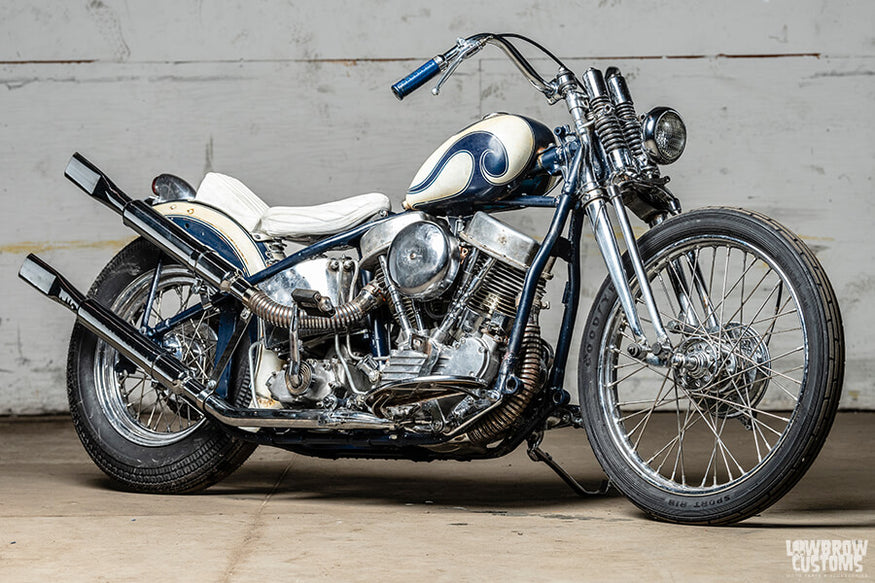
1949 Harley-Davidson Panhead built by: Marcus Ellis - Photo by: David Carlo
What is the best Harley-Davidson motorcycle base for a bobber?
There are many motorcycles that make a good basis with the features for a bobber project. When it comes to the best Harley-Davidsons motorcycle to bobber, the 1940’s 45 cubic inch Flatheads (typically known as 45s or WLs) are period-correct and far less expensive than Big Twin Harleys of the same era.
Sportsters of all year ranges are another good start, with Harley Ironhead Sportsters (1957-1985) and Evolution Sportsters being commonly available, and with many parts available.
Evolution-engined Sportsters are typically broken into three groups when it comes to parts availability.
- The 1986-2003 Sportster has a carburetor and the engine is rigid-mounted in the frame.
- The 2004 to current Sportsters have a different frame and the engine became rubber-mounted.
- From 2007 to current are also EFI (electronic fuel injected) instead of carbureted.
Best Triumph for a Bobber build
Triumph motorcycles are another popular bike to bob. Vintage Triumph parts are available in a variety of displacements, with the larger street models being 500, 650 or 750 cc.
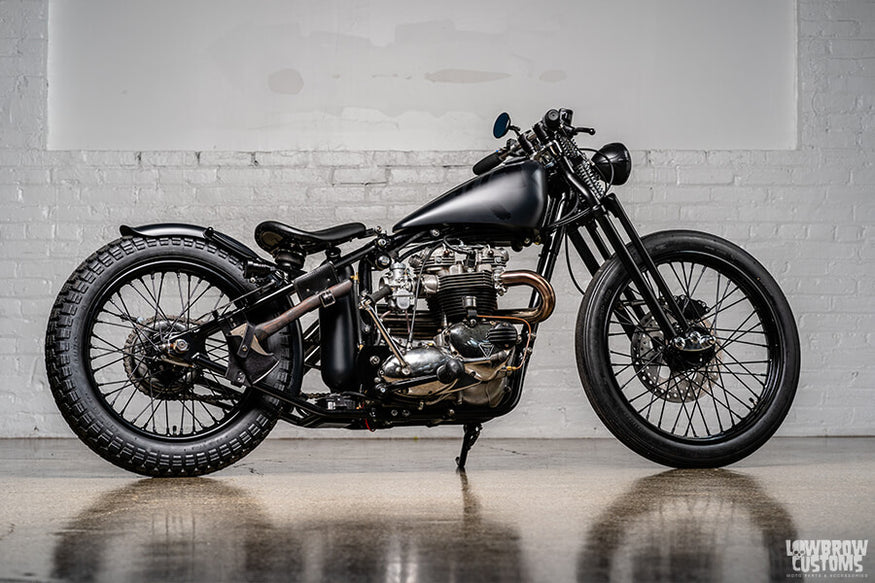
1969 Triumph T120 built by: Rob Chappell - Photo by: David Carlo
- The 1963 through 1970 Triumphs have a two-piece frame that bolts together, making it very easy to bolt on a rigid hardtail rear frame section.
- The 1971 and later Triumphs tend to be quite a bit less expensive, though the engine performance is improved and they are available as 750cc and with a 5-speed (instead of the earlier 4-speed) transmission.
- Parts are widely available for all year Triumph motorcycles. If you are looking for ease and reliability, a modern Triumph T100 or T120 Bonneville might be just what you are looking for.
- The early 2000’s Triumph T100s are carbureted motorcycles and have now been around long enough that you can find one for well under half of the price of a brand new one.
And of course, there is the new Triumph Bobber model which comes new from the factory with a frame that mimics the look of an earlier rigid frame. However that might defeat the purpose of trying to build a motorcycle in your own style, with your own vision!
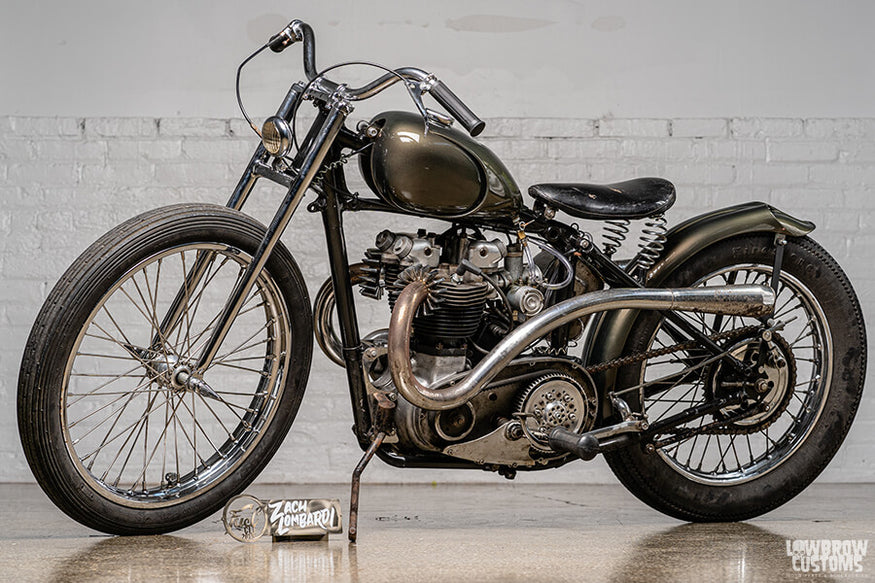
Top under $1000 motorcycles for a cheap bobber project
There are a large variety of metric motorcycles that can make a reliable and inexpensive bobber.
- Best bike for a cheap bobber build are parallel twin cylinder bikes such as Yamaha XS650s and the smaller displacement Honda CBs or Suzuki's mid-range 4 cylinder model 250s.
- You can also check out Honda CB350, 450, 500, 550 and 650cc models, the Kawasaki KZ650 B twin, and Yamaha CX750, 1000 and 1100, they all make good custom bobber builds on a budget.
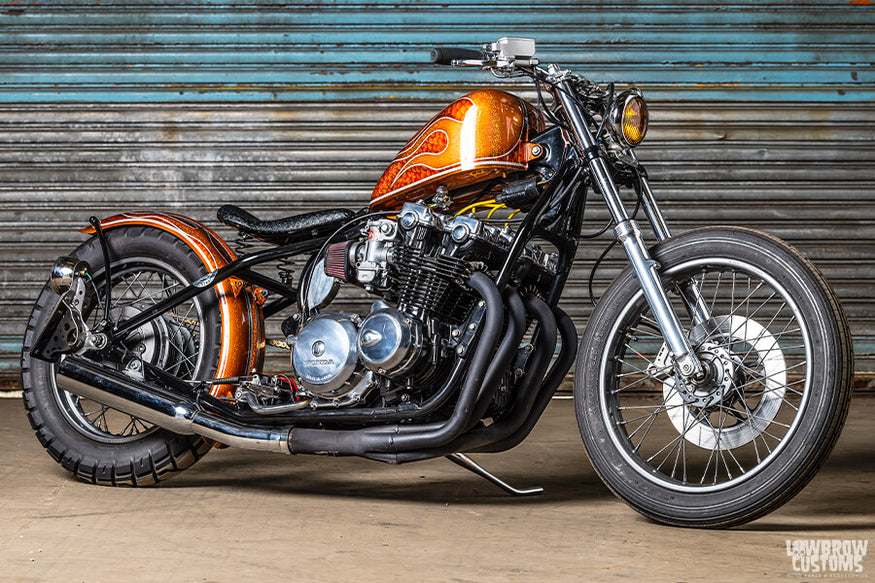
1980 Honda CB750 built by: Ry Seidler - Photo by David Carlo
- Another inexpensive option, as values on vintage motorcycles continue to climb, is the Kawasaki KZ440. They are a plentiful, inexpensive twin-cylinder bike that has a single frame backbone - (more on why this is important later in this article!).
- Other inexpensive motorcycles that are good candidates for a custom bobber are Honda CB350, 450, 500, 550 and 650cc models, the Kawasaki KZ650 B twin, and Yamaha CX750, 1000 and 1100.
All of these bikes can be found around $1000 with a bit of effort and luck and provide an excellent and reliable base for a builder on a budget.
How to build a bobber motorcycle?
Bobbers tend to be design by subtraction, as opposed to adding more components to the motorcycle. For this reason, they can be a good starting point for someone who is new to building a motorcycle from scratch, as this minimalist approach simplifies the process and helps you learn the fundamentals before adding more complex customizations.
In many cases, removing all the ‘unnecessary’ parts is as much work as adding the custom ones.
Choose the Parts for Your Custom Bobber Project Wisely
Consider which stock parts you will keep and use versus what will be removed, and what will be replaced. Many stock parts can be modified for a custom look by simplifying them by removing lettering or emblems or changing their finish with paint, powder coat or polishing.
Custom parts are widely available, though there is definitely a difference in fit and quality. Look for a reputable supplier that offers customer and technical support in case you have questions regarding installation.
A good parts supplier will also take returns should you not need a part or have a problem with one of their custom motorcycle parts.
While you can find inexpensive parts that do the job just fine, a bit of research can save you a lot of grief, and it tends to be enjoyable as well.
Ask questions or read posts on motorcycle forums or Facebook groups, read customer reviews of products, or reach out to the manufacturer with your questions before purchasing.
Of course, you can also make your own parts or modify existing ones. This takes more time and skill but is extremely fulfilling both during the work and later, when you are riding around on a motorcycle you build yourself.
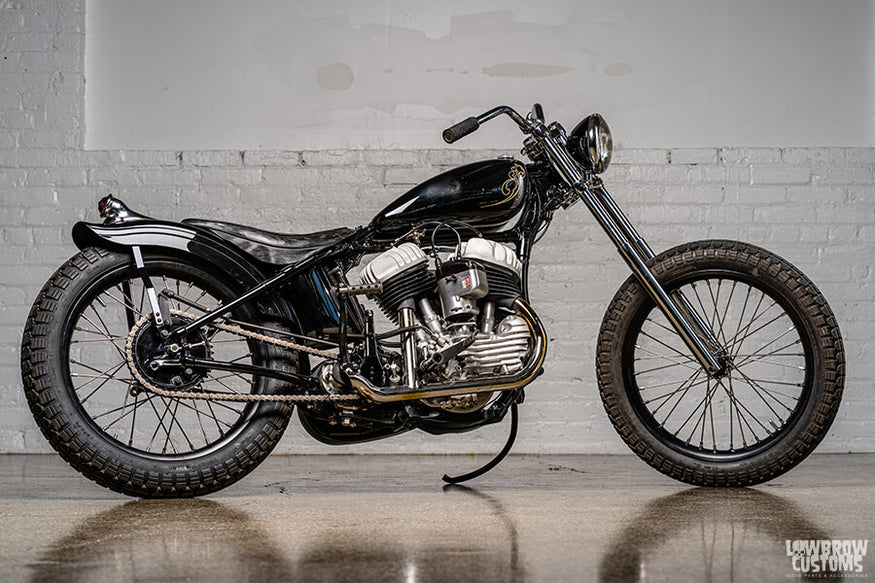
Harley-Davidson 45 WL built by: Chris Milanowski - Photo by: David Carlo
Get a Comfort and Handling Bobber Frame
When it comes to parts for your bobber, the frame is a crucial component. The original bikes that spawned the term bobber were all rigid. That is, they had no swingarm or shocks in the rear for suspension. The frame rails came down from the seat post to axle plates. Each bump in the road transmits directly to the rider, unless there is some suspension in the form of a sprung seat to dampen the vibration and jostles.
Even though it is a regression when it comes to comfort and handling, it is common practice to replace the rear section of a stock motorcycle frame with a rigid rear, known as a hardtail frame.
This hardtail frame section gives the bike some of the proper lines, with a straight line running from the neck down to the axle plate.
Depending on what motorcycle you choose to customize, a chopper frame kit may be available ‘off the shelf’ as a bolt-on or weld-on section.
Bolt-on hardtail frame sections are available for vintage Triumphs as well as Harley-Davidson ‘Ironhead’ Sportsters (and the Sportster’s predecessor, the K Model) from 1952 through 1978.
Most other makes and models of motorcycles need a weld-on hardtail due to the original frame’s design, such as a 1986-2003 Sportster Hardtail.
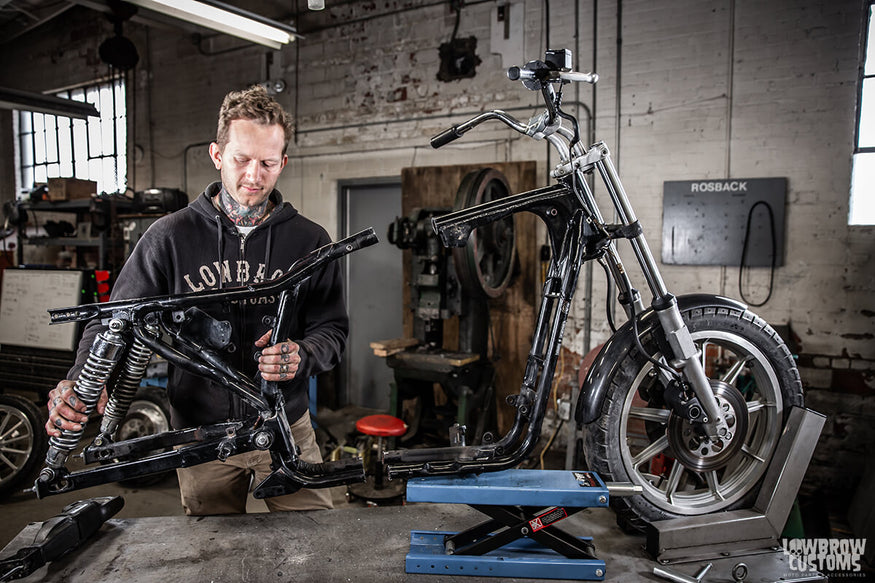
Tyler removing a freshly cut rear section of a Sportster in preparation to hardtail it
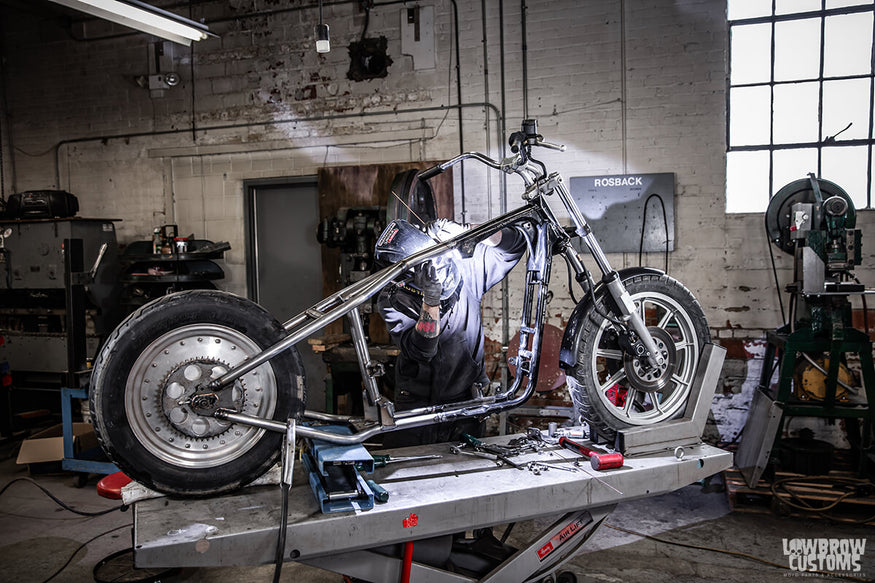
Tim welding up a 1982-2003 Sportster hardtail onto a stock Sportster frame.
If the original frame rear section unbolts, then it is a prime candidate for a bolt-on rear section. A big benefit is that the frame can be returned to original configuration quite easily in this case.
There is no benefit gained from welding a hardtail section in place if a bolt-on version is available for the motorcycle being customized.
These days there are hardtail sections available for many different bikes, including Harley-Davidson Sportsters, Shovelheads, Yamaha XS400 and XS650, Honda CB450K and CB750, Kawasaki KZ400, and many more.
If a hardtail frame section is not available for your project, you can locate a fabricator who has experience with custom motorcycle frames to undertake the job of modifying your stock frame.
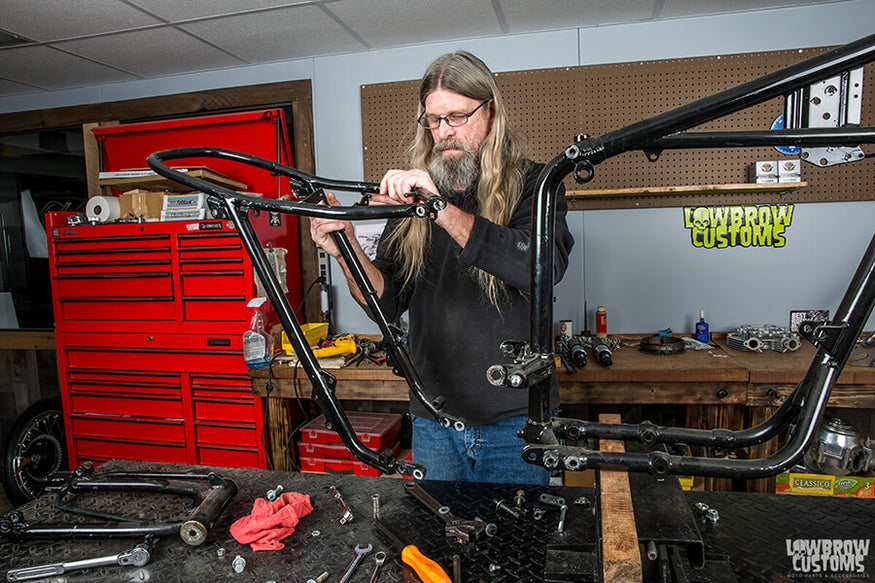
Todd removing a bolt-on swing arm frame to install a Lowbrow Customs Bolt-on Hardtail frame.
Modifying a stock frame, versus a full custom frame, has benefits in that you typically can keep the VIN number on your frame.
This, depending on your local laws, can allow you to customize your motorcycle without having to apply for a ‘special construction’ or otherwise modified title.
Changing the rear section of your frame will also will affect the stance of the motorcycle. When modifying the length of the hardtail section, or the height of the axle plates from the ground, you can alter the wheel base as well as the ride height.
In this situation, to keep your lower frame tubes parallel to the ground you may have to change or modify your front end to the proper length.
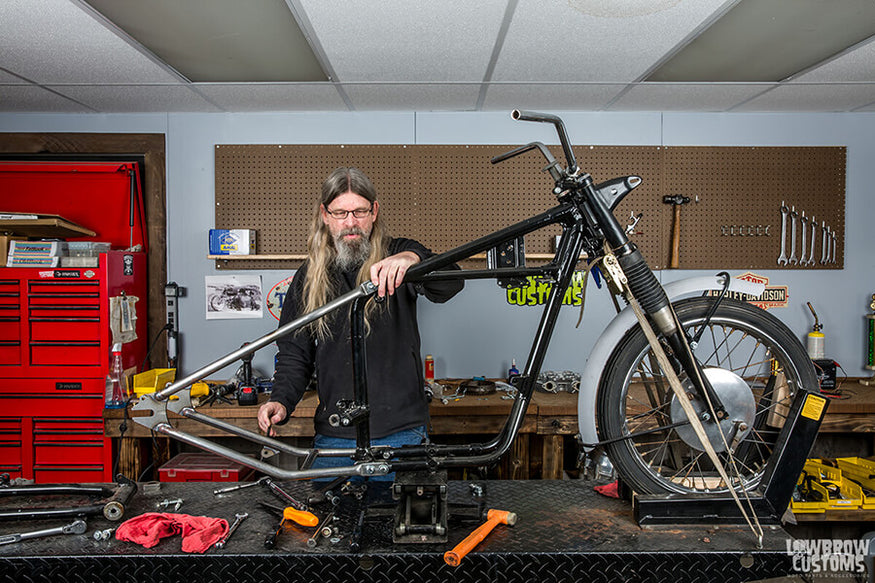
A bolt-on hardtail gives the option to go back to a swing arm frame if ever so desired.
This might mean shortening a front end by cutting down the length of your fork tubes and reassembling your front end, now shorter. It could also mean raking out the neck to a steeper angle, bringing your front wheel further forward of your motorcycle.
This also greatly affects handling, and is a style commonly associated with choppers. The difference between a bobber and chopper is a bobber tends to have a stock rake and shorter wheelbase versus a chopper.
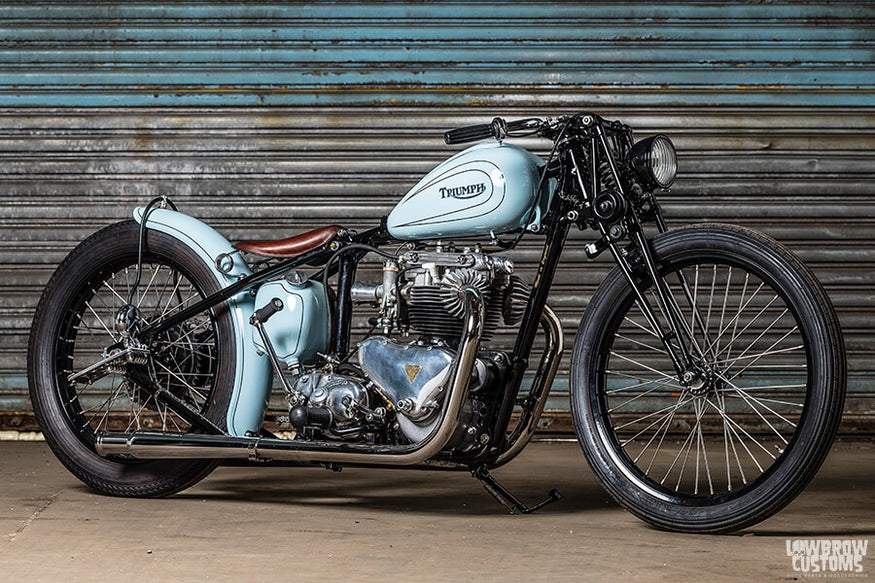
1957 Triumph T110 Pre-Unit built by: Dave Wilt - Photo by: David Carlo
Modification to change the Front end of Bobber build
Regarding front ends, there are many options available. One affordable method would be to use the stock front end from your motorcycle, simplifying it by removing reflectors and perhaps installing low-profile, small turn signals or removing them completely.
Front fender: Small changes such as removing the front fender, choosing perhaps a classic 5-3/4” diameter, bottom-mount or side-mount headlight with the necessary headlight mount, and different handlebars can completely change the look and style of your front end.
Lower fork legs: Another simple and inexpensive modification to change the look could be changing the finish by painting or powder-coating the lower fork legs. Installing rubber fork gaiters are another option that is inexpensive and can really give a classic look to your front end.
Springer front ends: In addition to customizing your stock hydraulic front end, motorcycle springer front ends definitely fit the bill when it comes to building a bobber. For a quick and affordable way to achieve that rigid, stripped-down bobber stance, consider installing 11 Inch Spring Struts. These struts replace your rear shocks, giving your bike the hardtail look without permanently modifying the frame.
Early Harley-Davidson springers can be found but often go for a large amount of money, even when damaged or incomplete.
New reproductions are available, such as the Cannonball VL springer fork, which look like the originals but are brand new and ready to use without repair. A lower cost option could be a Mid-USA Springer Front End, or similar style (DNA Springer, Paughco Springer etc.).
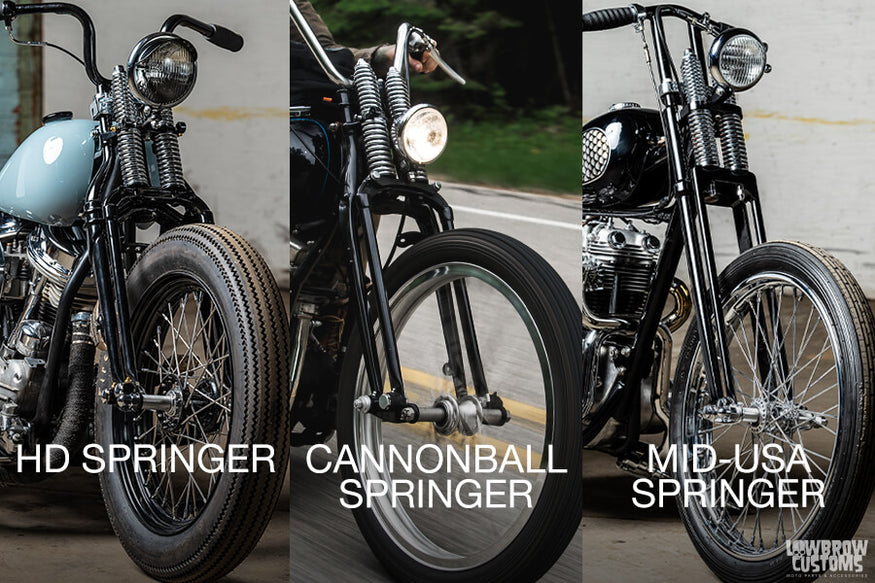
Here is a comparison shot of some of the springers I would recommend. From Left to right, Harley-Davidson Stock springers, Cannonball VL Springers, and a Mid-USA Springer.
Motorcycles can be dangerous, and you don’t want to risk your well-being with inferior quality parts. Similar to the rake or wheelbase of your frame, a stock length springer is typically what will look best on a bobber, versus a longer, chopper-style springer fork.
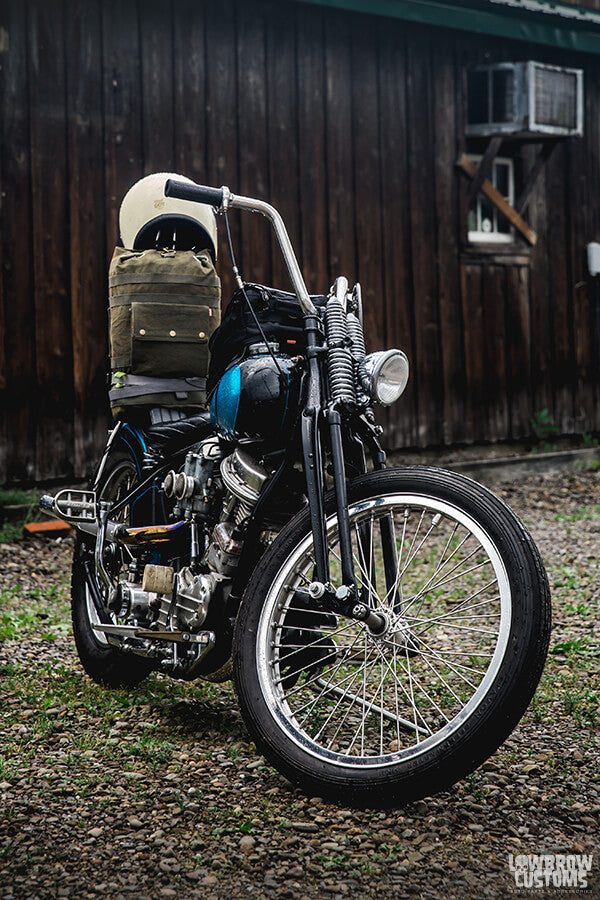
My 1959 Panhead, I added the Cannonball VL Springer front end about 2 years ago onto this bike and I absolutely love it!
Bobber wheels and rims that fit your axles, front end and frame properly
Is it worth building your own wheels?
When it comes to motorcycle wheels, spoked wheels are the go-to when building a bobber. If your project bike has spoked wheels you are in luck! There are also a variety of Harley-Davidson style complete replacement wheels available these days at reasonable prices.
The alternative would be a mag wheel, which are typically cast aluminum. You can build a cool bike with mag wheels, but they are not what existed during the early years of bobbed and custom motorcycles.
Building custom wheels can get expensive quick, though many custom hubs, rims and spokes are available for that exact purpose, and companies like Buchanan’s Spoke & Rim exist to make spokes, lace and true wheels for any motorcycle you like.
Alternatives can be cleaning up your stock wheels, or even disassembling and painting or powder-coating them.
Alternatively, by changing out the wheels you can choose a different rim size, greatly affecting the stance and profile of your motorcycle.
For instance, many vintage motorcycles have an 18” rear wheel and a 19” front wheel. This is a classic combination that performs well.
Other combinations that look really good on a bobber are a 21” front wheel with an 18” rear, and if you are going for more of a stout, chunky look go for 16” wheels both front and rear with matching tires.
There are some tires available that have vintage-styling yet are made with modern compounds. Tires that have a vintage look typically have the same width and sidewall height. This leads to a ‘taller’ tire that shows more rubber when viewing the motorcycle from the side. Modern tires tend to be lower-profile.
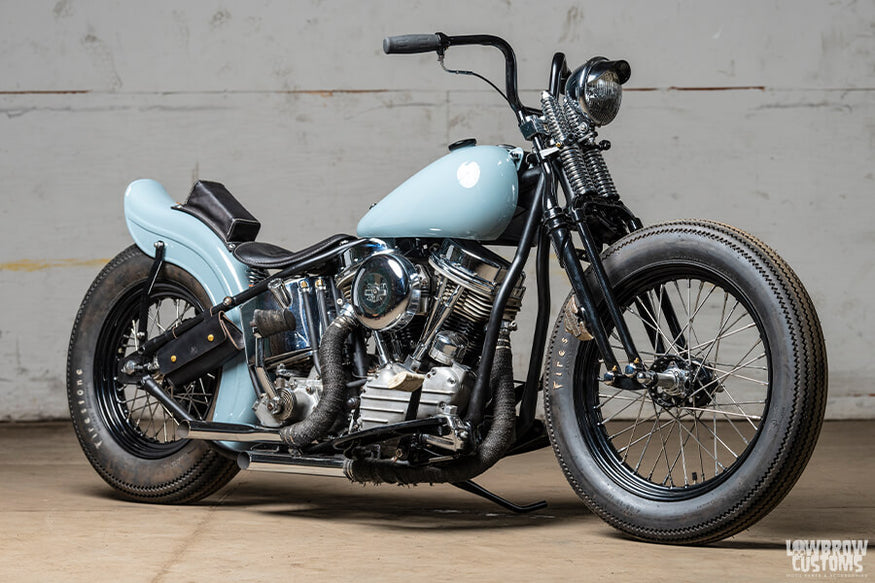
1959 Panhead built by: Kelley Runion - Photo by David Carlo
A classic combination for a bobber is an Avon Speedmaster 19” or 21” up front with an Avon Safety Mileage MKII 16” or 18” in the rear.
For a tire that can handle grass, gravel and dirt as well as pavement, the Bates Baja Tire is an excellent choice, with it’s unique, aggressive tread. These can be run as 16” both front and rear, a 16” rear / 19” front, 18" rear / 19" front. They are also available in a 21" front tire which pairs nicely with a 16" or 18" rear, though that tends to be slightly more of a chopper look.
Several companies also reproduce vintage tread patterns on motorcycle tires, though some are not DOT, that is, not speed rated by the Department of Transportation.
Can you get rims painted?
In regards to painted rims, while there are plenty of custom motorcycles that have been built with red rims and whitewall tires, this is not something that originated from early bobbed motorcycles!
It is something that was adopted from the hot rod scene into the custom motorcycle world in the last couple of decades. The old standby black or chrome works well on many bikes when it comes to the rims.
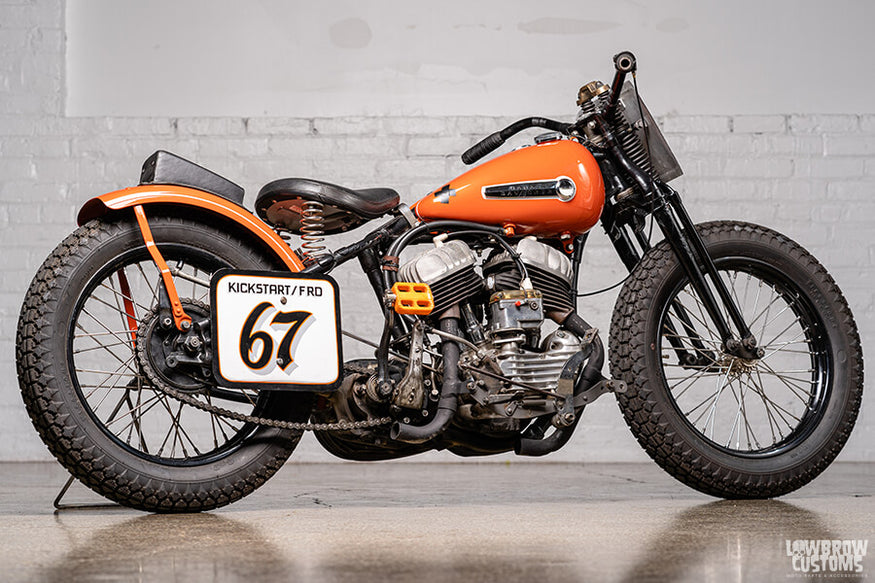
Using your stock wheels also simplifies the building process for most people, in that you have to ensure you have the proper hub and sprocket spacing to keep your chain lined up properly, and ensure that the wheels will fit your axles, front end and frame properly.
Looking for Custom Gas Tanks That Look Great on a Bobber
The gas tank and fenders (also known as the ‘sheet metal’) you choose to run are key components to the profile and stance of your motorcycle.
With many custom bobber gas tanks now available, the most simple method of mounting a gas tank on your project is to look for one that is made specifically to fit your make and model.
There are a large array of custom gas tanks for Harley Sportsters, for instance, and even more gas tanks that will bolt on with the use of Gas Tank Adapter Brackets. However, with some simple fabrication work, such as drilling holes in the frame backbone and welding in threaded steel bungs, a gas tank can be custom-mounted with ease.
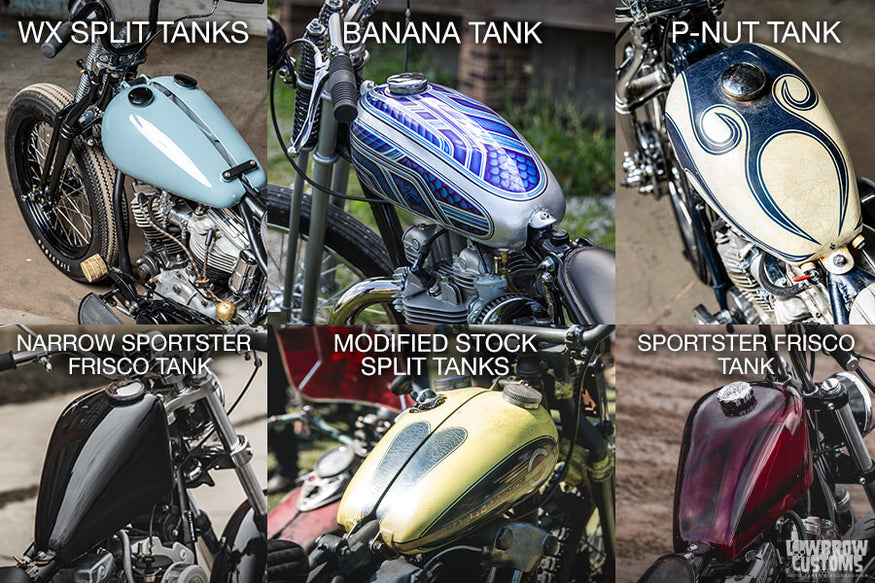
An ideal motorcycle for building a bobber will have a single, round tube for the backbone. This allows the use of many different aftermarket bobber gas tanks that are available.
Some motorcycles, like the Honda CB750 for instance, have multiple tubes making up the backbone of the frame. This makes using a different gas tank much more complicated, as custom gas tanks won’t typically have the clearance needed to fit a specific model with a unique frame.
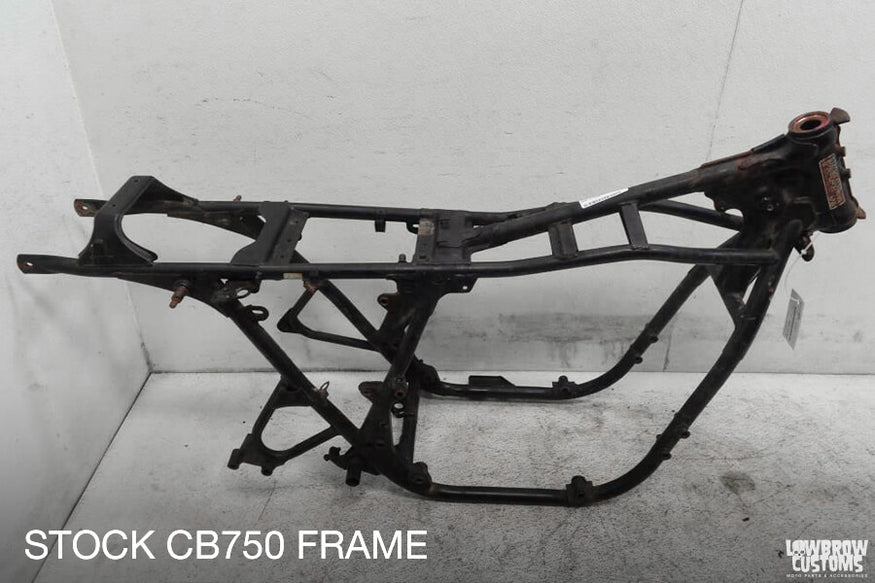
In this photo of a Stock Honda CB750 Frame you can see the 3 pieces that make up the backbone and hinder a lot of the use of after market gas tanks. This is why these are prime candidate for chopping up, loosing the weight and installing a hardtail section.
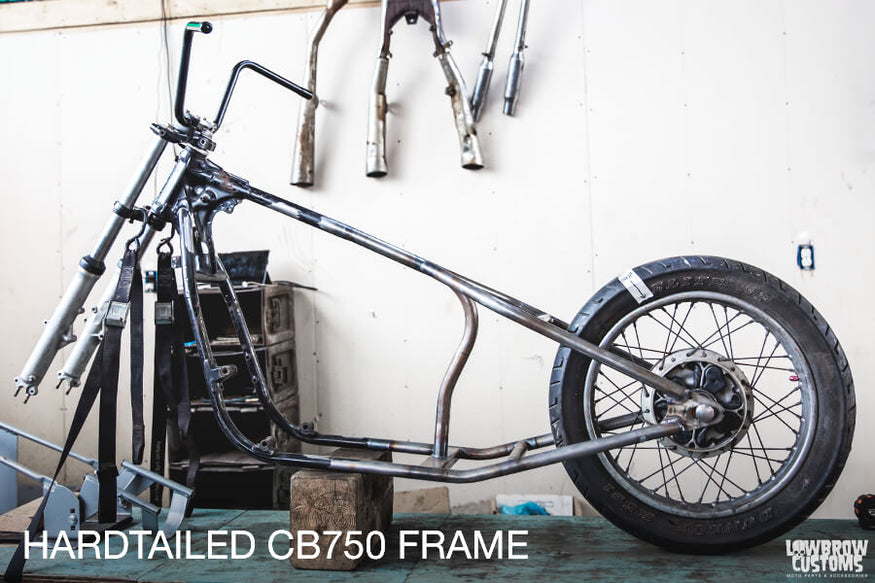
See how nice the backbone is on this Honda CB750 frame utilizing a Voodoo Vintage hardtail section.
Some other makes and models of motorcycles have a large square backbone. Sometimes you can find a gas tank that will have enough clearance to fit, however, the square backbone can tend to detract from the overall look of the finished bike.
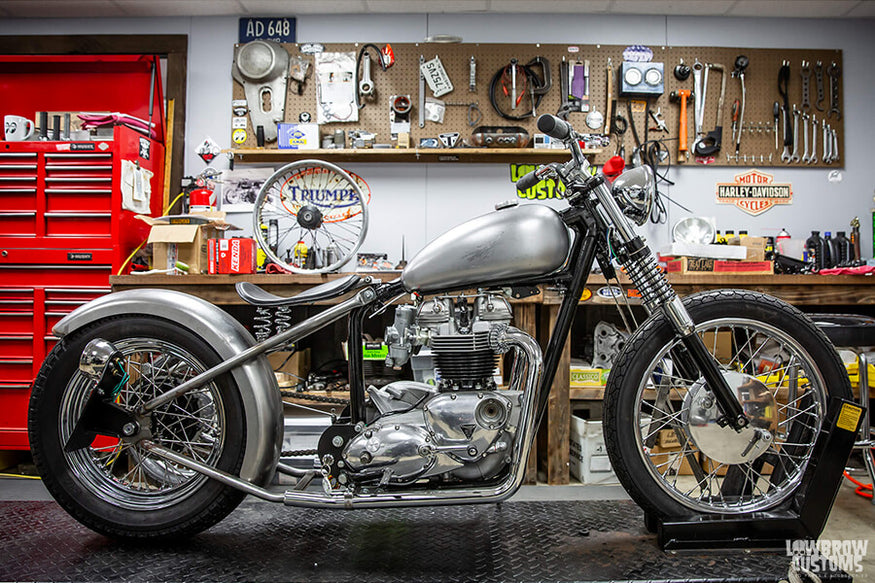
Todd's latest Triumph Bobber project. It's using our Banana Gas Tank and a Gasbox 16" Rear Fender along with a ton of other parts Lowbrow Customs offers.
To get around issues like this you need to either think ahead and start with a good candidate for a bobber, or plan to do some more serious work, like highly modifying the frame.
There are many custom gas tanks available these days that look great on a bobber. Another option is to find a gas tank you like from a stock motorcycle of any sort and modify the mounts so it will fit your frame.
Choose Useful Fenders for Bobber Style
Rear fenders are a key component of the style of your bike, as are the tires. The fender you choose to run has to be paired with the proper tires for your bike, and for the final look and design of the motorcycle. If you are reusing your stock wheels you may be simply using tires to fit these existing wheels.
Once you have decided on which tires you are going to use you can move on to the fenders. As we mentioned earlier, many bobbers have no front fender at all.
However, running a small smooth or ribbed front fender can be true to the bobber style and can be quite useful (especially when riding in the rain!). There are many styles of rear fenders available, in multiple different widths.
- Standard sizes include 4-3/4” inch, which work well on bikes with 4” and 4.5” wide rear tires (typically 18” and 19” rims)
- While a wider 6” fender is necessary for 130 width rear tires (as found on 16” rims).
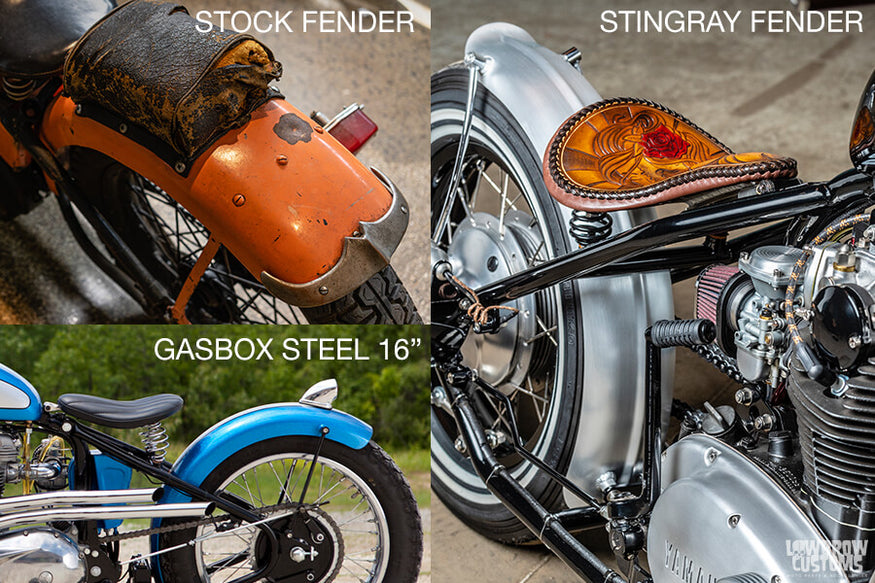
Here are just a few rear fender options out of the many that can be used to make your bobber stand out from the rest. Top left: A stock vintage fender. Bottom left: A Gasbox Steel 16" fender for vintage tires. Right: A Lowbrow Customs Stingray Fender that comes in widths of 4 3/4", 6", and 7".
It is very important to have proper tire-to-fender clearance when mounting your fenders. If you choose to run a modern-style tire and later switch to a higher-sidewall, vintage styled tire, you may have issues with the tire simply not fitting under your fender, or rubbing as it expands at high speeds.

You can see the hose on the rear tire on Todd's Triumph bobber project to help with the spacing of the rear fender. This helps set the distance between the tire and the fender.
One trick for mounting your fender is to tape a piece of old motorcycle drive chain, or a piece of garden hose or tubing, around the circumference of your tire where the fender will sit. You can set your fender on top of this chain or tubing, which will act as the clearance between your fender and tire.
You can now fabricate the fender mounts from your frame to fender, and your fender struts that support the end of the fender, without worrying about the fender being too close to the tire tread. A variety of weld-on fender mounts and fender strut kits are available to help the professional or home-builder alike.
Consider Oil tank for bobbers
Another important part to consider is the oil tank. Not all motorcycles have oil tanks, as some are ‘wet sump’ engines. This means that the oil is stored in the engine itself as opposed to a separate, stand-alone oil tank. A ‘dry sump’ engine utilizes an oil tank to store and recirculate the motor oil.
Some builders will make a dummy oil tank on a wet sump bike, such as a Yamaha XS650, as it is a convenient place to house any electronics or the battery. In many cases the stock oil tank on a dry sump bike can still be used on a bobber build.
Depending on the changes made to the frame you may be able to use the stock oil tank. If not, a popular choice is a cylindrical oil tank, which are available in a variety of styles, including domed or dimpled ends.
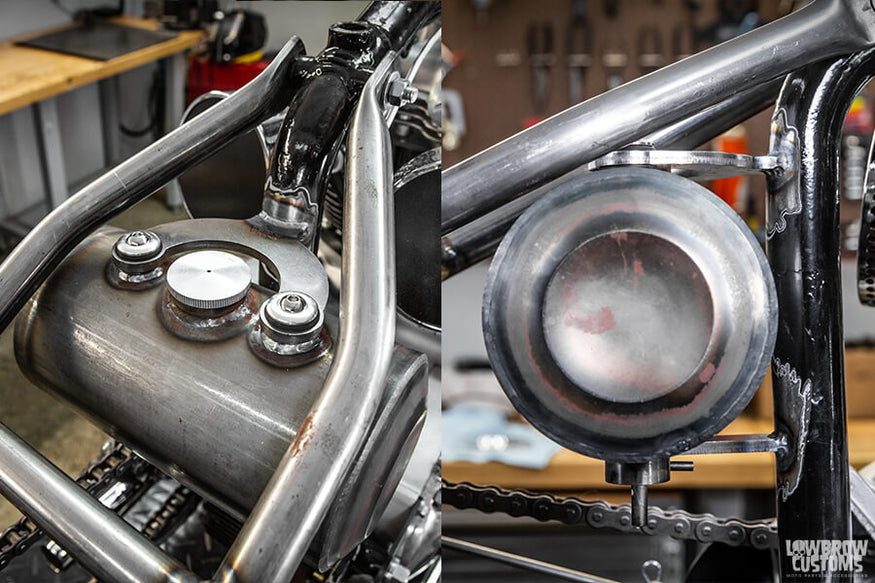
These custom bobber oil tanks will need to have mounts welded to your frame, but are otherwise very straight-forward to install. Hose fittings allow oil lines to be run to the engine and back with ease.
When mounting a custom oil tank be sure to make three mounting points. Less than this tends to lead to failure and broken mounts over time, and having the oil tank mounts crack on your bike is a great way to cause you some trouble on the weekend!
Rubber mounting your oil tank is an excellent way to isolate the oil tank from vibration, which protects the tank and mounts from cracking, and also keeps the oil from frothing or coming out of your breather vent. Different weld-on rubber mount tabs are available that make this a popular option.
Modify the Bobber Seats
Motorcycle seats come in many variations and styles, but there are a couple of differentiators to separate some of the styles.
Rigid mount seats
Rigid mount seats would be any motorcycle seat that mounts to the frame and does not offer any sort of support.
These seats are available as solo seats, in that it is just for the rider of the bike, and two-up seats, which also allow for a passenger.
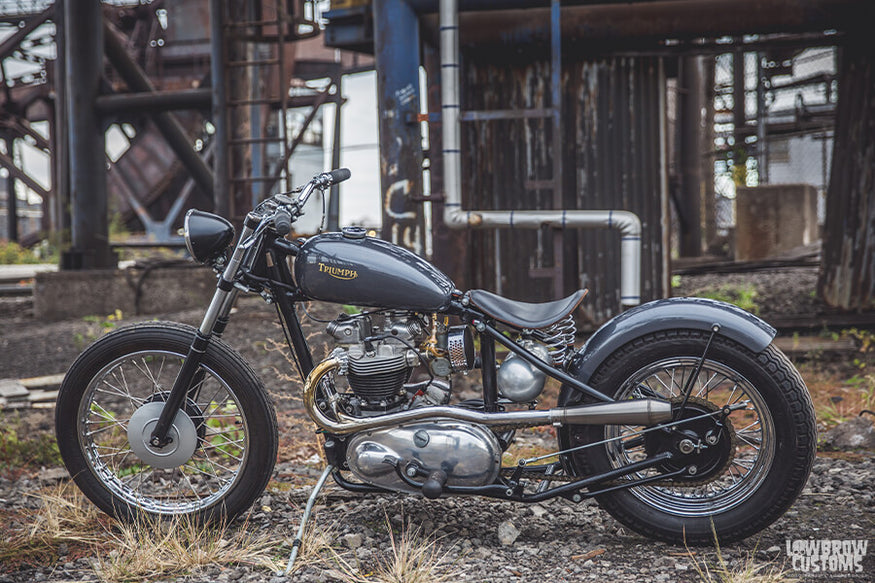
Another one of Todd's Triumph Pre-unit bobbers using a sprung solo seat, Banana Tank, Cylinder oil tank, and Gasbox 16" Steel fender.
Sprung seats /solo seats
Sprung seats are commonly called solo seats as well, but traditionally use springs between the rear of the seat and the frame, and a solo seat pivot at the front of the seat to allow it to pivot. This gives the rider some suspension to absorb the bumps and vibration from the road.
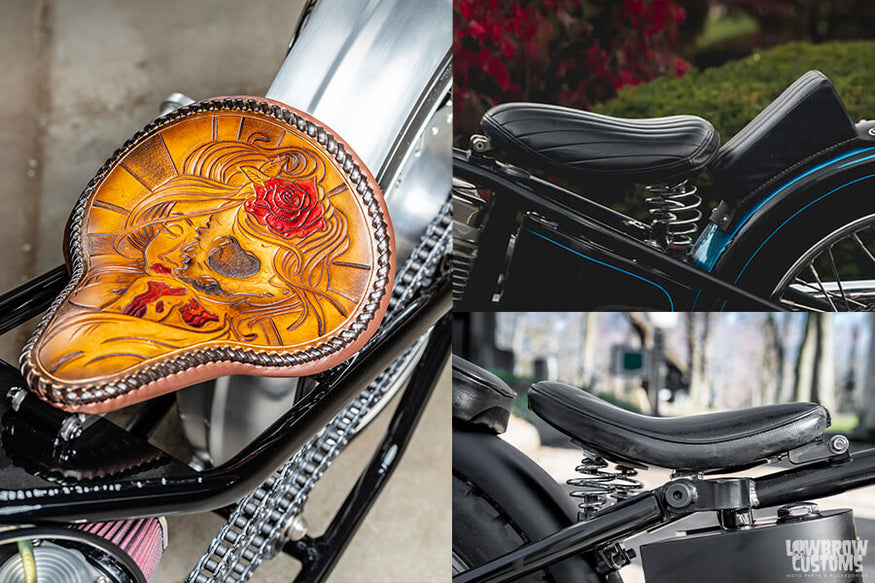
Original bobbers typically had a solo seat, which was often a larger saddle seat with a stock seat post. The seat support post slides into the stock frame and uses springs and bushings to give suspension to the rider and soften the ride. These types of seats are found on vintage Harley-Davidsons from early models like the Knucklehead and Panhead on up through Shovelheads.
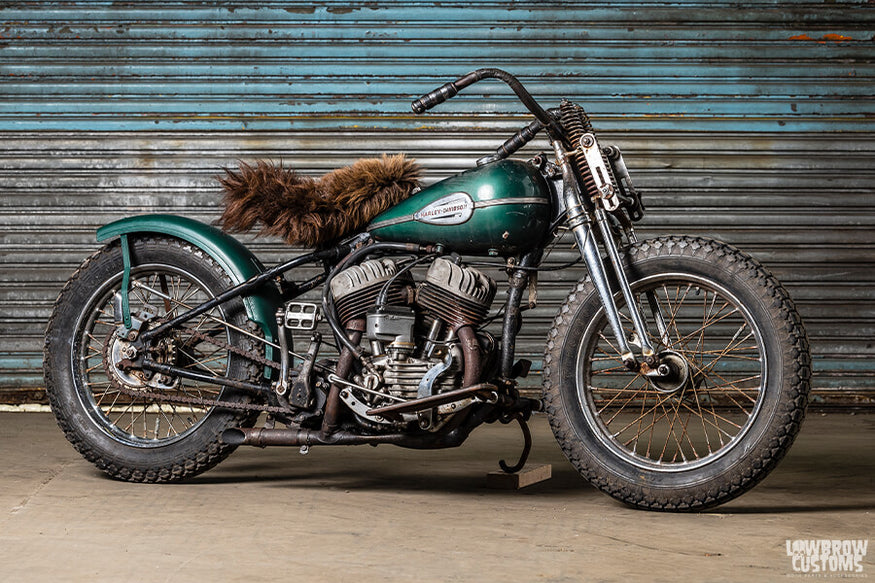
WL built by: Mel Stultz - Photo by: David Carlo
Smaller sprung seats
Smaller sprung seats made their appearance on customized bikes and early choppers, lowering the seating position of the rider. A sprung solo seat can easily be fitted to any hardtailed motorcycle.
They can also be installed on a bike with a swingarm, but profile of the bike doesn’t tend to work well as a bike with a swingarm has a more horizontal line than a hardtail, which angles down toward the axle.
In addition to the seat itself, a solo seat pivot, a set of weld-on or bolt-on solo seat spring mounts and some seat springs are needed to complete the installation.
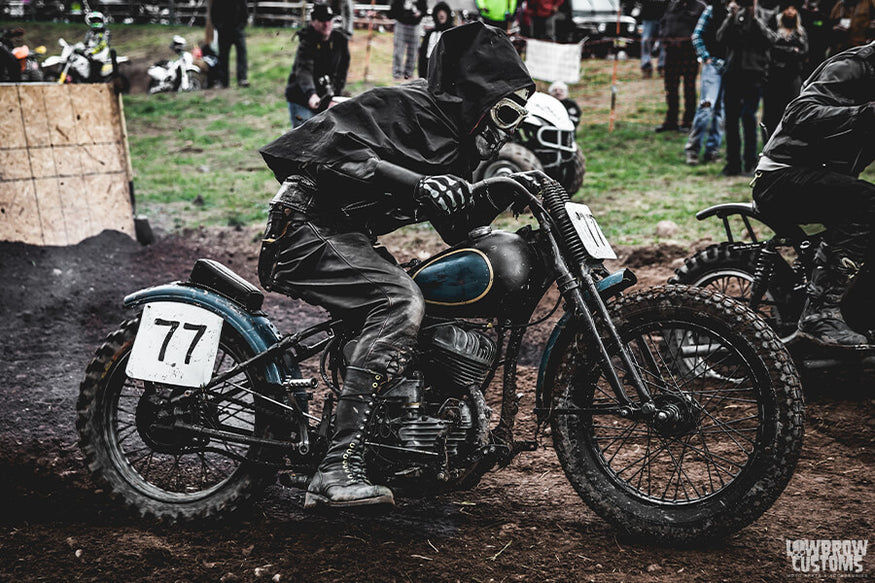
Josh Kohn #77 racing his WL at the App Moto Jam
How to build a bobber on a budget?
Finally, the cost is something to consider, both for the base motorcycle as well as for various parts necessary for the build.
As with any complex or large project, it is helpful to decide how much time and money you are going to spend on your project.
Having an overall idea of the money you have available will help determine what the starting bike will be, as well as other elements, such as whether you will have a professional paint job and chrome plating or aim to keep stock finishes or paint the bike yourself.
One way you keep your budget in check for a bobber build is by starting with a quality motorcycle to begin with. While it may seem like a good idea to buy an engine or a frame and piece the rest together bit-by-bit, this can often end up costing more money, as well as time, in the end. Getting a running, riding motorcycle will eliminate many potential expensive hassles during your build.
Your budget may also dictate if you are doing all the work yourself versus finding a professional to help with mechanical or fabrication on your build. The finish work, that is, polish, painting and plating, can often be a large part of the expense of building a bobber.
If you are on a tight budget consider high temp painting or ceramic coating an exhaust instead of chrome plating it, learning to paint your tank and fenders yourself, and going with materials for handmade parts such as aluminum or stainless steel. These can be sanded and finished with scotchbrite or buffed to a shine on your own buffing wheel instead of having to be plated at a higher cost.
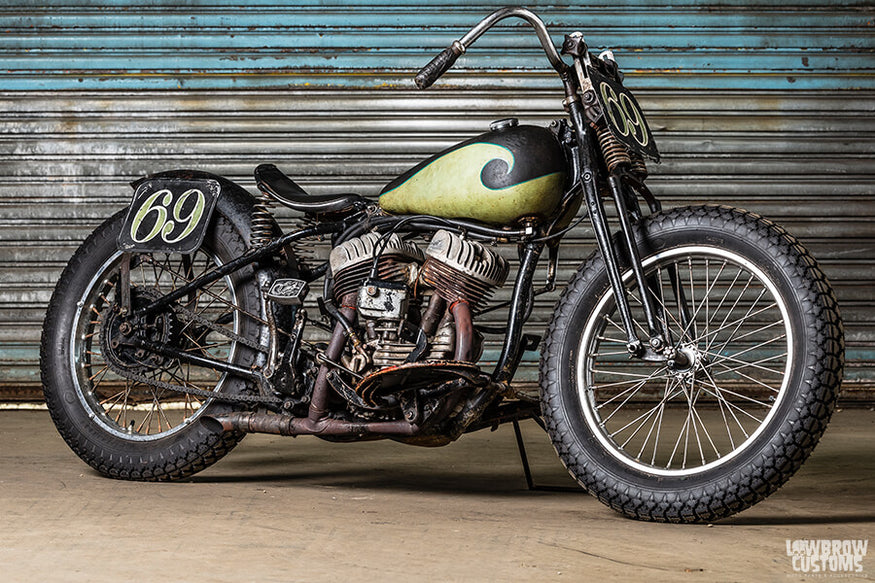
1945 WL built by: Daniel Desoucey - Photo by: David Carlo
Building a custom motorcycle and then getting to ride it down the road can be extremely satisfying and give a real sense of accomplishment. In my personal experience, the time spent riding a motorcycle I built with my own hands is greatly enhanced because I know that machine inside and out.
If a problem arises, I am much more likely to be able to fix it than a bike I didn’t modify or assemble. Motorcycling offers such room for growth in terms of mechanical and fabrication knowledge that it is almost endless.
It is a pursuit that pays dividends in many areas of life, as the knowledge carries over to so many other activities. And of course, being able to take the vision that exists in your head and make it a reality is fulfilling.
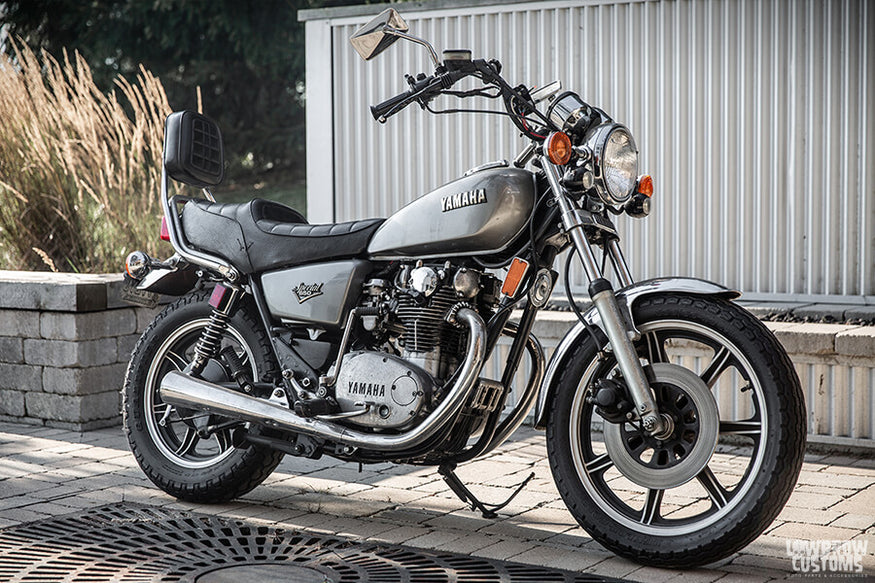
A stock, early 1980's Yamaha XS650 motorcycle, which is a great option as a starting point to build a bobber motorcycle.
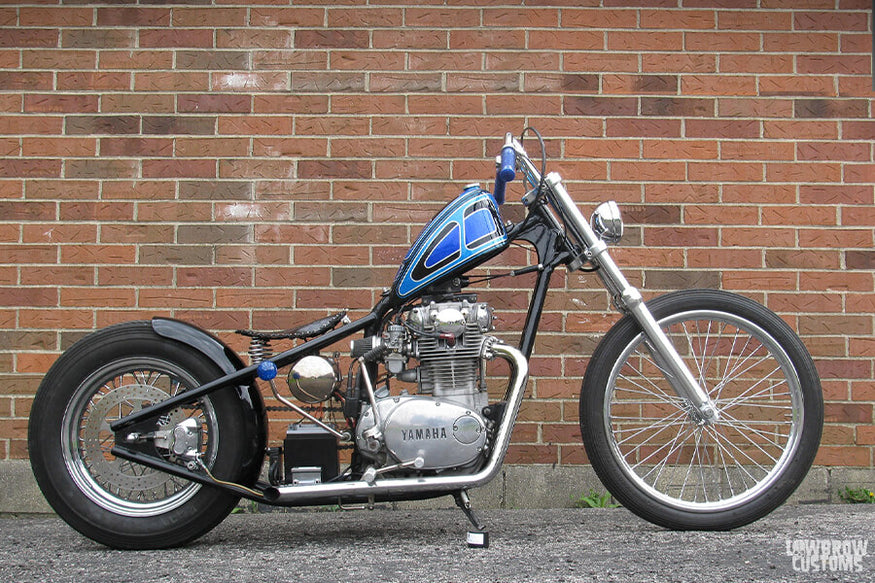
A custom Yamaha XS650 chopper, quite the difference from the stock motorcycle pictured just above!
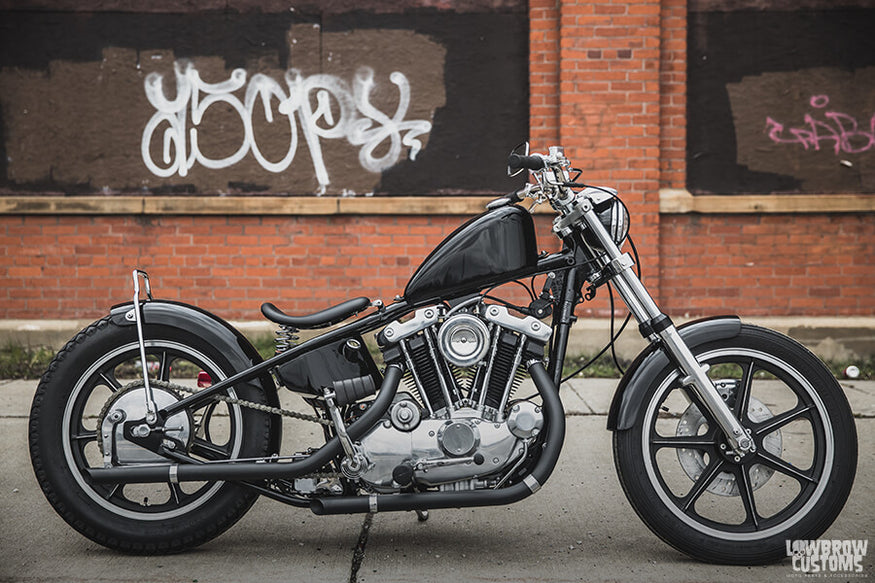 Harley-Davidson Ironhead Sportster bobber built by The Gasbox.
Harley-Davidson Ironhead Sportster bobber built by The Gasbox.
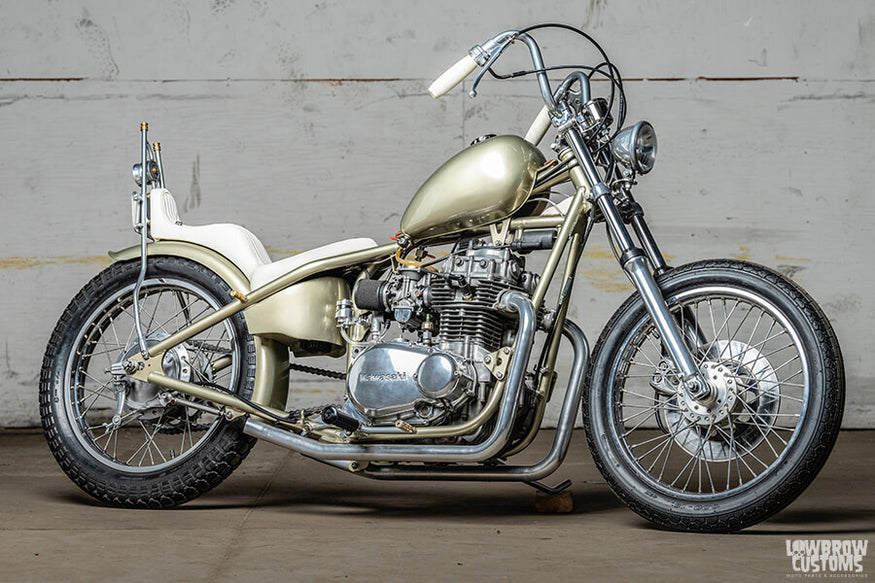 1981 Kawasaki KZ440 bobber was built by: Chris and Heather LaCour. Photo by: David Carlo
1981 Kawasaki KZ440 bobber was built by: Chris and Heather LaCour. Photo by: David Carlo
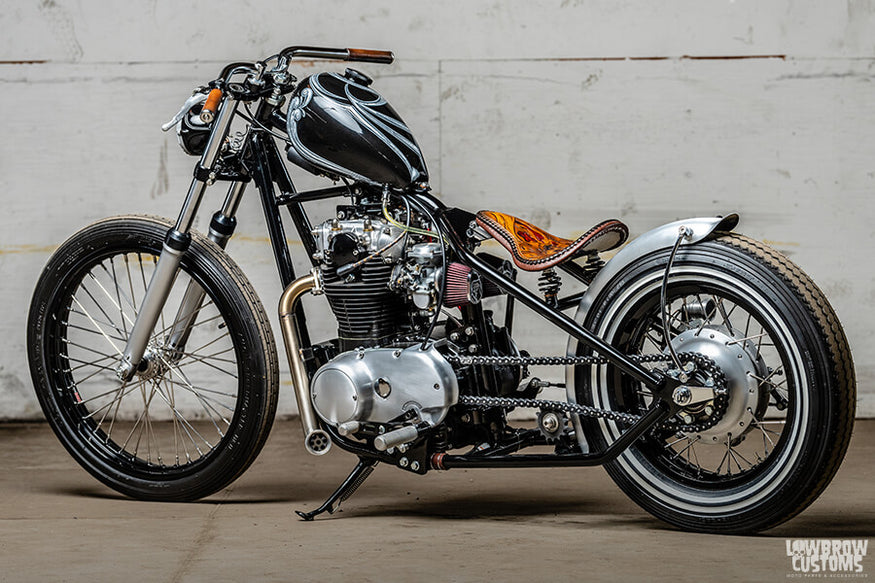 1977 Yamaha XS650 built by: Austin Andrella - Photo by: David Carlo
1977 Yamaha XS650 built by: Austin Andrella - Photo by: David Carlo
 Here's another one of Todd's vintage Triumph bobber builds.
Here's another one of Todd's vintage Triumph bobber builds.
By Tyler Malinky, Lowbrow Customs

Scroll down and leave a comment at the bottom of this article:
Related Products











